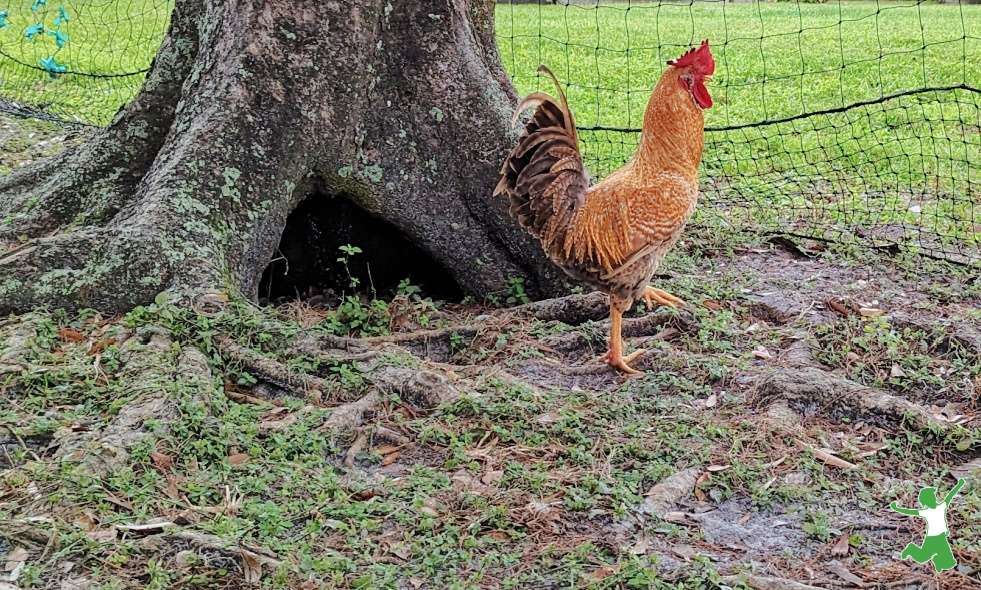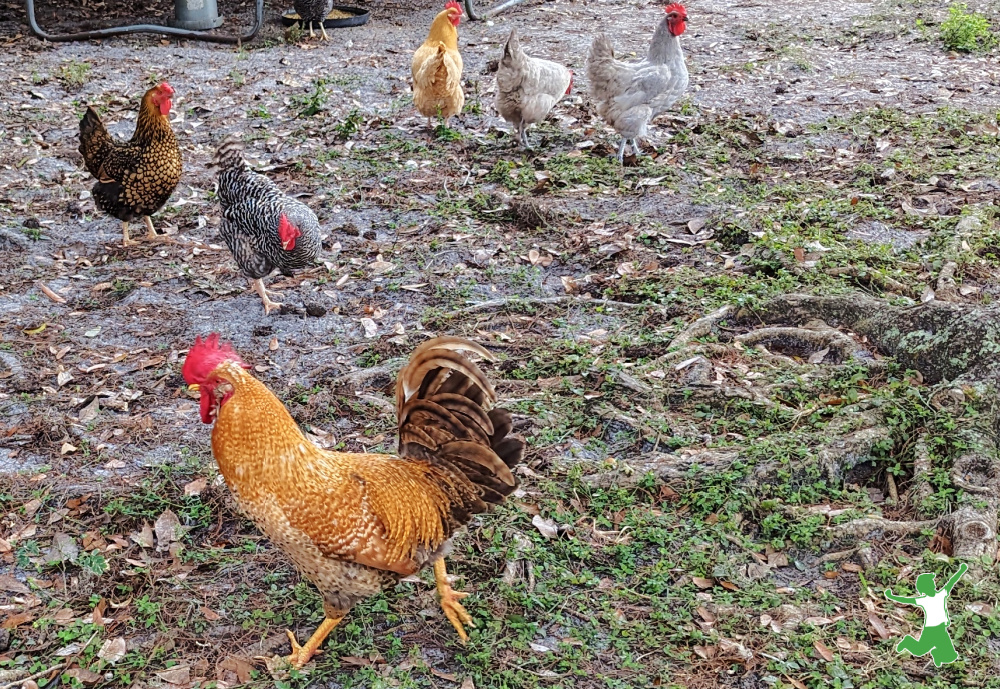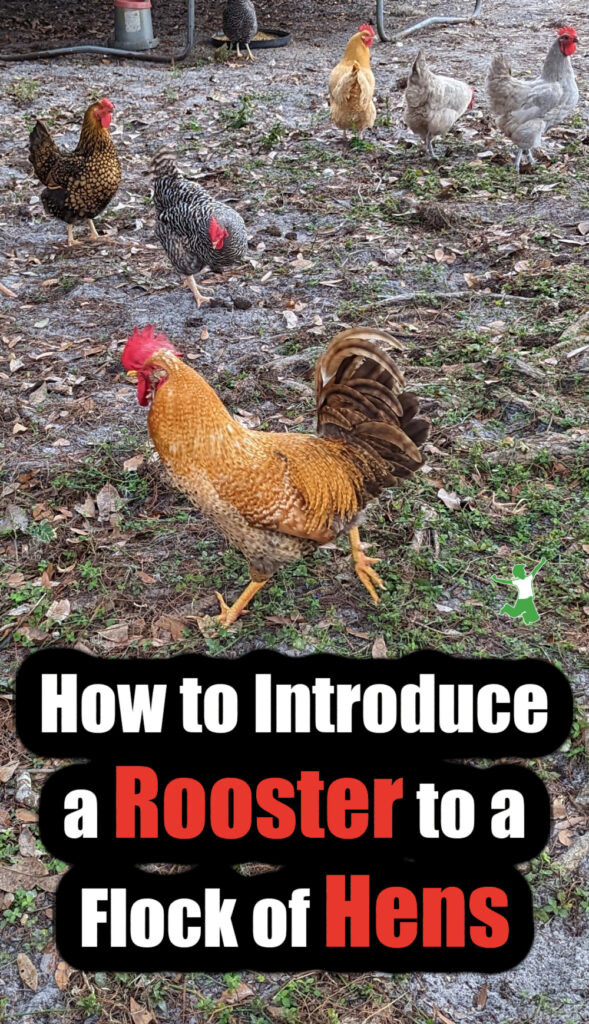The simple and straightforward process for choosing a cockerel or rooster to introduce to an existing flock of laying hens.

I’ve chronicled my backyard layer hen journey on this blog for the past 10+ years.
It’s been a fun and very successful endeavor, which has provided our family with top-quality eggs with minimal issues for over a decade.
Despite the old saying “if it ain’t broke, don’t fix it”, my husband and I recently decided to add a rooster to the mix…
The following reasons are why we made this major change after so many years:
- I want to hatch my own chicks to ensure the long-term viability of our flock without reliance on the increasingly dystopian chick hatcheries.
- Raising my own chicks from fertilized eggs to full-grown hens will produce healthier birds that are not traumatized by the medicalization of chick hatcheries and the inhumane shipping process.
- The watchful eyes of a rooster will help protect my hens from red-tailed hawks that have moved into our area over the past year.
- I want to take our home egg-laying operation to the next level of sustainability without any reliance on the commercial egg industry.
Choosing the Best Rooster
When you decide to get a rooster for your laying flock, it is very important to choose wisely.
I am fortunate to have a rooster sanctuary not far from my home.
This farmer takes in young cockerels from people who were raising chicks and inadvertently got a rooster instead of a hen from a feed store or hatchery.
Thus, I had the opportunity to observe numerous roos before I settled on Rocky (pictured above).
Rocky is huge, but very gentle and does not charge people (a common aggressive behavior to watch out for).
Because I was going to introduce Rocky to an existing flock of grown hens that had an established pecking order, a young cockerel or small rooster wasn’t going to cut it.
I needed a big guy who would be able to hold his own from day 1.
I also needed a large rooster who would be able to fend off hawk attacks on my girls. This has become an increasingly distressing problem for me over the past year (never was an issue in years past).
Even though Rocky is barely a year old, he fit the bill on all counts.
Is Quarantine Necessary? Yes and No
Many online sources will tell you that a two-week quarantine is necessary before introducing one or more new chickens to an existing flock.
However, the farmer who runs the rooster sanctuary told me that this was not necessary under some circumstances.
First, my flock was all hens with no existing rooster that would compete with Rocky.
He would be the alpha from the get-go.
Secondly, since he had cared for Rocky for many months and his chickens were all healthy (living in the same community as mine), I could introduce Rocky right away to the hens with very little to no chance of communicable illness.
Third, Rocky is huge and would be able to easily hold his own against any bullying tactics a cantankerous hen might try.
Introducing a Rooster to a Flock of Hens
After considering what Farmer Del told me, I decided to introduce Rocky immediately even though I already had a quarantine area set up for him as necessary.
I also decided to introduce him in the middle of the day instead of at night after all the hens were roosting as some sources recommended.
The reason for this was based entirely on Rocky’s size.
He was not going to get bullied, so sneaking him into the coop at night while the hens were asleep was not necessary.
How Did it Go?

Rocky’s introduction to my hens was nothing short of hilarious.
When I opened the travel cage and let him loose in the free-ranging area, the hens looked completely shocked and amazed.
They literally did not know what to do with themselves 😂
Rocky fit right in immediately. No ruffled feathers or feelings at all.
My one grumpy hen has tried to challenge him a couple of times, but Rocky’s large size keeps the situation under control without any worry.
In the coming weeks, I will be writing about my adventures with Rocky and the hens.
I am looking forward to collecting fertilized eggs to compare them with unfertilized eggs for taste and storage differences.
I am also excited to begin hatching my own chicks.
Stay tuned!
What is Rocky’s Breed?
By the way, if any of you have a clue about what Rocky’s breed might be, please let me know your thoughts in the comments below.
Farmer Dell thinks he is a blend.
My guess is an Orpington/Plymouth Rock mix?









He’s beautiful! I may have visit farmer Del. We’ve never had good luck with Roosters. I’ve had too many that charged at me.
He has another rooster right now who is sweet and won’t charge. I didn’t get him because he was smaller than Rocky, and I was thinking he might not work with older hens like mine who are in an established pecking order and set in their ways.
He’s beautiful! I’m considering adding a rooster as well, but perhaps a bantam to minimize the crowing.
Can you elaborate on the dystopian hatcheries?
Will have to elaborate in a Plus article. Not something I want to share in a public article that can get shared on social media.
Yes, please do! We can’t get chickens yet because we don’t have the space. I am afraid by the time we do, there will be mRNA in the chicken hatcheries and we will have to try to find someone local or something. I don’t want to vaccinate any chickens we get and all the hatcheries’ chicks are hatched out of vaccinated chickens. Sigh. Oh the world we live in these days!
He is a handsome rooster, and not only can you produce your own replacements, but fertilized eggs are also more nutritious than unfertilized eggs. I used to raise laying hens in a moveable cage, but my neighbor’s dogs always killed them. Had one batch of 12 stolen the first night I put them outside. I can deal with a hungry animal eating my chickens but a thief stealing them or a dog killing them just for the sake of killing, is terrible. The dog doesn’t know better and the thief, well they are just thieves. Next time I get some chickens, I will make sure I have a portable electric fence to go around their pen. Eggs cost $8.86 a dozen now and I would love to have the fresh eggs my hens used to lay. The farmer that I get my meat and raw milk from got out of the egg business after losing over 130 hens from stray dog attacks.
He looks like he might be a Bielefelder. We have 3 of them. McMurray Hatchery has pics of them on their site. They are beautiful and supposedly one of the friendliest roosters around. Ours are only 9 mos oks, but so far we agree.
😊
Thank you for identifying him! So happy to know his breed finally.
Yes, he’s quite friendly … I can pick him up even though he is huge and could hurt me if he wanted to!
A reader emailed and said that Rocky may be a Rhodebar rooster. They both look so similar!
Hello Sarah,
I was hoping you could help me answer one question. I bought some bagged chicken feet, and did not notice (didn’t check – didn’t think I had to) that almost all of them have black spots. After I defrosted some of them, I noticed that almost all of them have black spots in the middle of their “paws”. I emailed the vendor and he told me that it is perfectly safe to eat, and that these are scratches that they get in the winter because the ground is hard.
I know nothing about the chickens, but I have never seen round scratches. They all look like a disease, some kind of infection.. I searched online, and I think they look like what people call bumblefoot. I found some info for the people who raise the chickens – how to treat it etc, but I can’t find an answer to ARE THEY SAFE FOR HUMAN CONSMUMPTION question.
As it is hard to find chicken feet in my area, when I found them I bought a lot, and.. if they are not safe, of course I will get rid of them, but if they are safe, even though it is grose , I would cut the affected areas out and use them for stock. If you are able to help or refer me to someone who could , I would appreciate it greatly.
Thank you kindly
Jolusia
This article should hopefully explain when chicken feet are and are not good to use for broth (with pictures). https://www.thehealthyhomeeconomist.com/chicken-feet-benefits-uses/
Hope that helps.
I agree it’s likely bumble foot. Personally, unless I was dehydrating the feet to use for dog treats, I would cut out any black spots. Bumblefoot is an infection that chickens can get in their feet if they get cut and then bacteria gets into it. I’ve had to treat my chickens forward a couple of times.
Handsome guy!!
He seems to think so to! LOL Watching him strut his stuff in front of the ladies is quite entertaining.
He looks like one of my Bielefelder roosters! That breed is also known for gentle roosters and have big combs like that.
Yay! The mystery is solved. Thank you so much for letting me know.
What a great story! Welcome to the flock Rocky! Sarah, do you have any thoughts/ opinions about using hemp bedding or sand in the coop? We have heard mixed reviews on sand.
Here are my thoughts on the materials I’ve used. https://www.thehealthyhomeeconomist.com/best-chicken-coop-bedding/